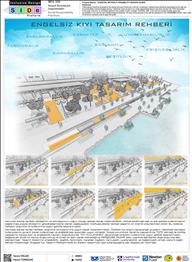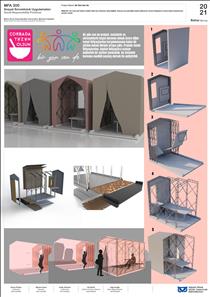Loading
A Guide for Barrier-Free Shores

DESIGNED BY:
Yaren Yoluk, Harun Türkcan, Tuğçe Akgün (SCPAT)
INTRODUCTION:
Public spaces should be arranged under everyone's access and use in the city; especially the coastal access should be designed with appropriate standards to enable disadvantaged groups'/wheelchair users' use and access. Within the framework of the project, we have worked with The Spinal Cord Paralytics Association of Turkey concerning participation in public life, and the issues and potentials in public spaces in the city were identified with the NGO design partner. These issues and potentials have been further studied with the synthesis study and the "Guide for Barrier-Free Coasts" was prepared that focus on coastal areas from the perspective of equal participation in public life. The guide in question was developed as a model based on the coastal area of Perşembe Pazarı.
At the beginning of the project, possible design directions were evaluated with the NGO design partner. A consensus was reached to prepare a "Coastal Design Guide" for public spaces and agreed upon that this will be demonstrated on a sample location, and thus, the Perşembe Pazarı coastal area was re-interpreted by 3D modelling based on the relevant guiding criteria. The study was also related to "awareness-raising" intention. The coastal area of Perşembe Pazarı, which is located at the centre of Istanbul, has been chosen for its location, urban landscape value, and suitability for all city dwellers' accessibility and public use. In order to make the principle-based design interventions more understandable, certain fundamental notes on the coastal design were taken through a literature study before the 3D modelling stage. The principles were determined based on the concepts common in different resources and were considered the criteria to be included in the design guide to meet user expectations regarding the design of coastal areas.
The Principles of the Guide for Barrier-Free Coasts:
The main idea of the project is to enable individuals with disabilities to use the coastal areas without any barriers and at the same time, offer all users a comfortable spatial experience. With the example of the coastal area of Perşembe Pazarı, it was shown that the obstacles exist in spatial arrangements. Individuals who have difficulties in participating in public life experience problems in accessibility not because of their impairments/disabilities, but due to the disadvantages caused by the design of public spaces themselves. The suggested project aims at resolving these issues.
Yaren Yoluk, Harun Türkcan, Tuğçe Akgün (SCPAT)
INTRODUCTION:
Public spaces should be arranged under everyone's access and use in the city; especially the coastal access should be designed with appropriate standards to enable disadvantaged groups'/wheelchair users' use and access. Within the framework of the project, we have worked with The Spinal Cord Paralytics Association of Turkey concerning participation in public life, and the issues and potentials in public spaces in the city were identified with the NGO design partner. These issues and potentials have been further studied with the synthesis study and the "Guide for Barrier-Free Coasts" was prepared that focus on coastal areas from the perspective of equal participation in public life. The guide in question was developed as a model based on the coastal area of Perşembe Pazarı.
At the beginning of the project, possible design directions were evaluated with the NGO design partner. A consensus was reached to prepare a "Coastal Design Guide" for public spaces and agreed upon that this will be demonstrated on a sample location, and thus, the Perşembe Pazarı coastal area was re-interpreted by 3D modelling based on the relevant guiding criteria. The study was also related to "awareness-raising" intention. The coastal area of Perşembe Pazarı, which is located at the centre of Istanbul, has been chosen for its location, urban landscape value, and suitability for all city dwellers' accessibility and public use. In order to make the principle-based design interventions more understandable, certain fundamental notes on the coastal design were taken through a literature study before the 3D modelling stage. The principles were determined based on the concepts common in different resources and were considered the criteria to be included in the design guide to meet user expectations regarding the design of coastal areas.
The Principles of the Guide for Barrier-Free Coasts:
- Accessibility: Public spaces can be described as areas where interaction and circulation are intense in the city. Ensuring that it is used equally and fairly by everyone will allow social interactions to occur. As one of the most critical elements of urban life, public spaces should be designed considering everyone's access and use. Surrounding street connections, public transportation, pedestrian crossings, accessibility to open spaces are factors affecting accessibility. Areas of which are designed for accessibility are the ones that are heavily occupied by users. The provision of access to public spaces for individuals with disabilities and enabling them to use space comfortably are directly connected with the concept of accessibility. Following this principle, pedestrian paths, ramps, railings, stairs, landscaping, urban furniture and areas for resting in public spaces should be designed in accordance with users’ needs. Thus, a holistic design approach will contribute to the creation of more habitable environments.
- Diversity: One of the most important indicators of the quality of public space is its diversity. The concept of diversity can be considered concerning factors like different activities and usage times for different users and flexibility in using the space. With this concept, it is possible to create combined usage areas for different individuals open to being used by all and increase the public space's quality in question. The combined usage areas can be related to one another to contribute to the improvement of the space.
- Awareness: Public spaces are areas that are open to everyone’s use. The designs that appeal to all users, including individuals with disabilities and create easy-to-use spaces, will play a critical role in raising awareness of the needs of disadvantaged groups, not only in public spaces but also in urban life.
- Character: One of the most important factors shaping the public space is its character, which specifies areas of interest of the users of public spaces. Factors such as size, scale, historical memory, typology can be listed as the elements that constitute the character of public space. When starting the design, the texture, scale, cultural values, and the characteristics of the users of the region should be considered.
- Connection: One of the most important criteria that determine the quality of public spaces is the principle of connection. This principle in public areas can be indirectly associated with the principle of accessibility. Public spaces with strong environmental connections are also diversified in terms of their target user.
- Publicness: City-dwellers develop social relations through encounters in public spaces within the public sphere. Therefore, in line with the principle of publicness, it should be aimed to realize the design of space where individuals can move freely.
- Adaptability: It is important for the designed areas, as part of the design and application process and in line with the design principle of adaptability, to consider changing needs, and to include adaptable properties which could be applied to other areas as well. When designing public spaces following the principle of contextuality, first of all, the texture of the region, scale, cultural values, the user audience must be considered.
The main idea of the project is to enable individuals with disabilities to use the coastal areas without any barriers and at the same time, offer all users a comfortable spatial experience. With the example of the coastal area of Perşembe Pazarı, it was shown that the obstacles exist in spatial arrangements. Individuals who have difficulties in participating in public life experience problems in accessibility not because of their impairments/disabilities, but due to the disadvantages caused by the design of public spaces themselves. The suggested project aims at resolving these issues.
Please login to post comments

